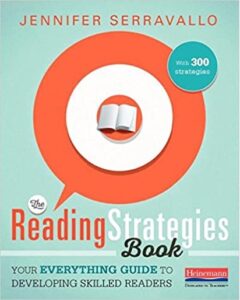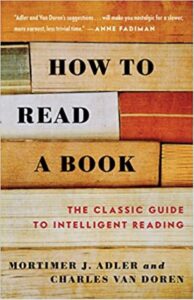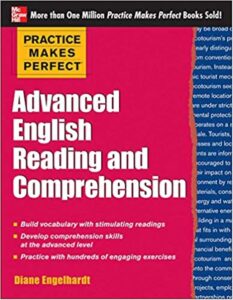Have you ever noticed that you fail to grasp any meaning out of it when you read a particular passage? How many times we sit down to read a passage and find ourselves reading and rereading a paragraph because none of it makes sense. I know it is an absurd occurrence because reading should equal comprehension, right? Although that is what most of us believe, however, reading something doesn’t ensure that you will understand the meaning behind it. Reading words as they appear and deriving meaning out of them are two separate things.
Due to the limitations in the way we are taught in school, most of us don’t develop the reading comprehension skills that are required to decipher meaning from text. This is made worse later on in life when we encounter difficult books in college and beyond. The good news is that it is never too late to brush up on your reading comprehension skills. In this article, I will provide the ten best books to help you improve your comprehension abilities.
In this Article
- 1. The Reading Strategies Book: Your Everything Guide to Developing Skilled Readers
- 2. How to Read a Book: The Classic Guide to Intelligent Reading
- 3. Visualization Skills for Reading Comprehension
- 4. Essential Reading Skills, Preparation for High School
- 5. The Art of Comprehension: Exploring Visual Texts to Foster Comprehension, Conversation, and Confidence
- 6. I Read It, but I Don’t Get It: Comprehension Strategies for Adolescent Readers.
- 7. The Reading Comprehension Blueprint: Helping Students Make Meaning from Text
- 8. Practice Makes Perfect Intermediate English Reading and Comprehension
- 9. Practice Makes Perfect Advanced English Reading and Comprehension
- 10. Reading Development and Difficulties: Bridging the Gap Between Research and Practice
1. The Reading Strategies Book: Your Everything Guide to Developing Skilled Readers

This is by far the best of the lot. It is a perfect blend of strategies and practical advice to help you better understand written work. You will find some 300 tried and tested methods in this book that cover everything from fluency to literary analysis.
Key Features:
- Develop goals for every reader
- Give students step-by-step strategies for skilled reading
- Guide readers with prompts aligned to the strategies
- Adjust instruction to meet individual needs with Jen’s Teaching Tips
- Craft demonstrations and explanations with her Lesson Language
- Learn more with Hat Tips to the work of influential teacher-authors.
Get it here.
2. How to Read a Book: The Classic Guide to Intelligent Reading

“How to read a book” is an all-time classic. It was initially published in 1940, and this version was revised in the 1970s. The book does exactly what it says in the title; it teaches you how to read a book effectively. You will learn how to pace your reading and how different genres require different approaches.
Key Features:
- Learn how to pace your reading for maximum effectiveness.
- Covers a wide range of difficulties – elementary reading to speed reading.
- Learn how to “X-ray” a piece of text to derive meaning from it critically.
- Includes a host of different techniques that work for different genres.
Get it here.
3. Visualization Skills for Reading Comprehension

This book is ideal for those who cannot visualize as they read. Visualization skills are vital for comprehension, and some of us do it naturally while others have to learn it. You will learn how to create mental pictures as you read a passage for a richer experience.
Key Features:
- Improve your inferencing and prediction abilities by visualizing written test.
- Step-by-step activities to quickly build the ability to visualize information while reading.
- Gradually increments difficulty.
- No-prep. No extra materials are required. Worksheets are designed for ‘six-minute sessions.’
Get it from here.
4. Essential Reading Skills, Preparation for High School

Don’t be thrown off by the title. Although this book is catered towards high school students, any adult can effectively improve their reading comprehension. Lessons focus on how to read effectively using practical strategies.
Key Features:
- 36 complete lessons to support classroom teaching or as a self-study guide
- Filled with graphic organizers and helpful visual reminders to improve student s reading comprehension.
- Learn practical strategies for different genres of text.
- Covers – strategic reading, non-fiction texts, and fiction texts.
Get it here.
5. The Art of Comprehension: Exploring Visual Texts to Foster Comprehension, Conversation, and Confidence

“The Art of Comprehension” will teach you how to read texts by using what the author calls “access lenses.” You will learn about the connection between visual and written texts and how to use your imagination to derive meaning.
Key Features:
- Discover inventive ways to prompt students to notice, think about, and synthesize visuals—using the same observation and comprehension skills they can bring to reading and writing.
- Learn about ways to unravel layers of meaning in picture books, chapter books, artwork, poetry, and informational text.
- Explore the book’s eclectic collection of art and illustration by acclaimed illustrator Peter H. Reynolds, 19th-century masters, and more.
- Learn about “access lenses” (such as faces, body language, sound/silence), which prompts students to become active explorers and meaning-makers.
Get it here.
6. I Read It, but I Don’t Get It: Comprehension Strategies for Adolescent Readers.

The title says it all. It is indeed widespread that not all reading leads to understanding. This can be found in people of any age as it is not just restricted to children. This book will learn a myriad of strategies that will help you understand text better from different genres.
Key Features:
- Thoughtful explanation of current theories of comprehension instruction and how they might be adapted for use with adolescents.
- What Works section in each of the last seven chapters offers simple ideas you can immediately employ in your life.
- Teaching tips and ideas that benefit struggling readers as well as proficient and advanced readers.
- Appendixes with reproducible materials that you can use in your classroom, including coding sheets, double-entry diaries, and comprehension constructors.
Get it here.
7. The Reading Comprehension Blueprint: Helping Students Make Meaning from Text

This book is ideal for teachers and students alike. It goes deep into comprehension and uncovers meaning methods that can be employed to understand better written work.
Key Features:
- Get critical background knowledge by utilizing decades of research on reading comprehension.
- Teachers will get a complete framework for organizing instruction, aligned with Scarborough’s Reading Rope’s language comprehension strands.
- In-depth chapters are devoted to each facet of reading comprehension, including vocabulary, syntax, and sentence comprehension.
- Learn everything about text structures, background knowledge, and levels of understanding and inference.
Get it here.
8. Practice Makes Perfect Intermediate English Reading and Comprehension

This book uses exciting topics such as deep-sea treasure hunting, Pixar Studios’ computer-generated movie magic, the Flying Doctors of Australia, and more to help students learn reading comprehension. You will also find vocabulary resources in the book.
Key Features:
- Develop your reading comprehension skills at the intermediate level
- Build your English vocabulary
- Prepare for the comprehension sections of ESL tests.
- Master how to read for main ideas, summarize texts, make outlines, remember facts and figures, and more.
Get it here.
9. Practice Makes Perfect Advanced English Reading and Comprehension

Unlike the previous book by the same author, this one focuses on advanced texts such as academic journals and news articles. You will learn how to interpret different texts and derive meaning from them.
Key Features:
- Build your academic and technical vocabulary
- Boost your comprehension skills to an advanced level
- Create reading strategies to use with any problematic text
- Develop critical thinking skills
Get it here.
10. Reading Development and Difficulties: Bridging the Gap Between Research and Practice

If you want to understand reading comprehension problems from a research perspective, this is the perfect book. It will dive deep into the various studies conducted on comprehension and offer solutions to some of the biggest challenges.
Key Features:
- Learning the structure of language at the word level.
- Reading comprehension and reading comprehension difficulties
- Assessing reading in second language learners.
- Effective prevention and intervention for word-level reading difficulties.
- The neurobiological nature of developmental dyslexia.
Get it here.
